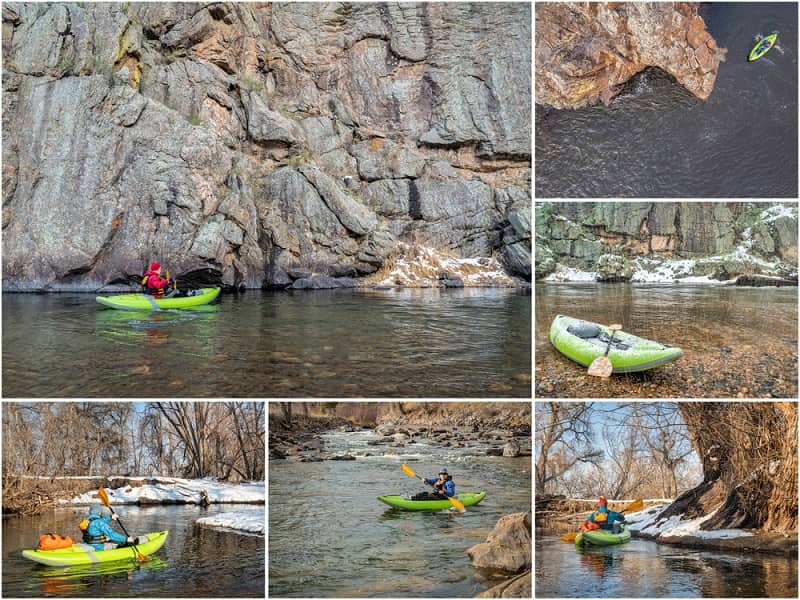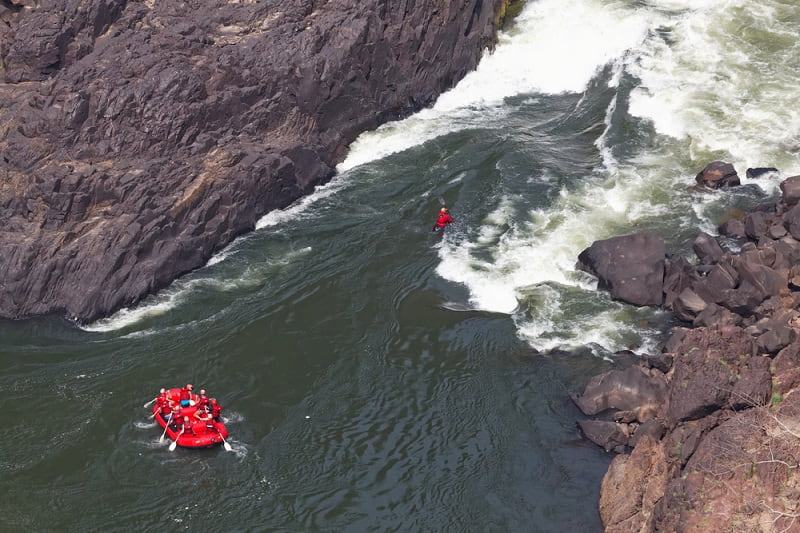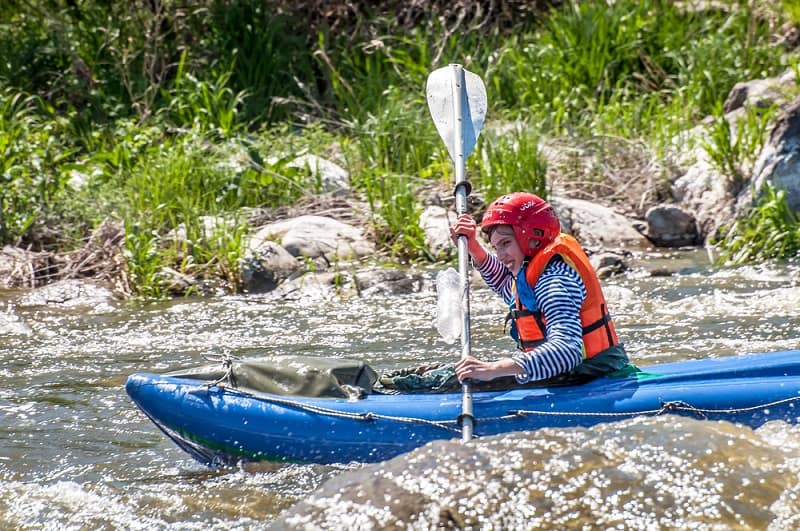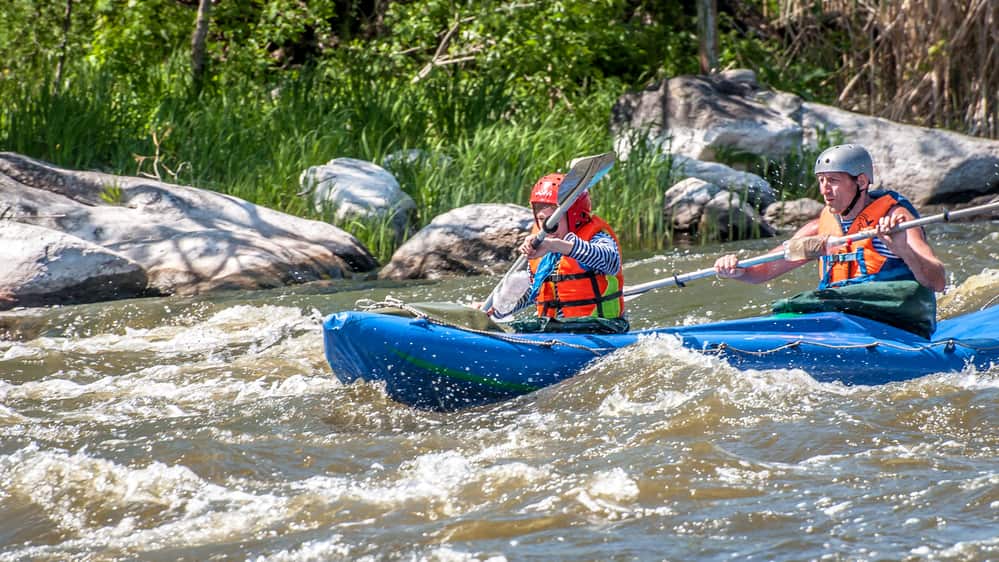If you’re thinking about planning a whitewater outing, you may be considering whether you should use your inflatable kayak or not.
Inflatable kayaks are convenient to store and pack, and are often cheaper than traditional kayaks, but are they equipped to manage whitewater?
You may be facing several challenges while out on the water, such as rocks and turbulent water, which may sound daunting for your inflatable boat.
In this article, we will explore whether or not your inflatable kayak should be able to tackle whitewater paddling.
First, let’s get you familiarized with whitewater in general.
Table of Contents
Whitewater Classifications (Important!)
Not all whitewater is how you may envision it; it is not always highly turbulent and extreme.
Whitewater can be classified into six possible classes, and they are generally noted in Roman numeral fashion (class I through class VI).
Class I is considered the least violent, while class VI tends to be more extreme.
Rivers themselves are not noted as one particular whitewater class; you can have multiple different whitewater classes on a single river, depending on the rapids it contains.
Let’s take a closer look at each whitewater class so you can know what to expect on your trip before you go.
Class I
As mentioned, Class I will be the least violent of the classes.
You can expect relatively calm water, with potentially very light ripples in the water. Paddling will be very easy and there is little danger or risk of tipping over your kayak.
Class II
Class II is where you will begin to see some actual rapids.
The water will be moving a bit quicker and the ripples/rapids will be a little more prominent than Class I.
You will want to have decent kayak maneuverability skills before tackling Class II whitewater, but overall these rapids will not be super extreme.
Class III
Class III starts getting a little rough. You will find many relatively high waves, and will certainly need prior experience in navigating whitewater.
Maneuverability will be required, and you will most likely be fitting your boat through narrow openings in the rocks.
Class IV
Class IV is considered to be difficult. There will be longer stretches with more intense rapids, which require advanced maneuverability.
The danger risk is certainly elevated. In advance of your trip, you should have plans in place in case either you or a member of your group goes overboard.
Class V
Class V is considered very difficult. You will find long stretches of intense rapids.
Water will be moving very fast at a possibly steep grade, and you can encounter some relatively big drops.
You must be highly skilled in whitewater and maneuvering.
Class VI
Class VI is considered the most extreme whitewater. This class must be handled very seriously, as this water is extremely dangerous.
You will be flirting with significant injury or death if you are not a legitimate expert and properly prepared.
It is necessary to be familiar with these whitewater classes, as you can find out what whitewater classes you may be facing on your particular river.
Now that we have covered these classes, let’s see how your inflatable kayak may hold up in whitewater.
Can You Use Inflatable Kayaks in Whitewater?

Inflatable kayaks are more durable and whitewater-prepared than you may think.
In fact, many whitewater rental facilities use inflatable kayaks and rafts to rent out to their customers.
Can Inflatable Kayaks Handle Rapids?
Inflatable kayaks are very capable of handling rapids. These kayaks are surprisingly stable and operate very similar to your regular hardshell kayaks.
Many of these inflatable kayaks can be rated to withstand up to even Class IV rapids. Things start to get a little dicey with Class V and Class VI rapids.
Inflatable kayaks are probably not the wisest option for water that rough. You will get a lot of water in your kayak and you run a high risk of tipping over.
For rapids that extreme, many enthusiasts prefer to be in a big, stable raft or a hardshell kayak with a spray deck to prevent water from coming in.
Can Inflatable Kayaks Go Over Rocks?
Having a rock puncture your inflatable kayak can be a real concern, but these kayaks are fairly durable.
Many of these kayaks are made with heavy-duty material, such as a thick PVC.
You won’t have to worry too much about a puncture, although it may be a wise idea to carry a repair kit with you just in case.
These punctures can be repaired rather easily.
Overall, your kayak should be able to withstand a rough beating. As with most things, the price and quality will play an integral part in just how durable your kayak could be.
Are Inflatable Kayaks Safe to Use in Whitewater?

Overall, inflatable kayaks are quite safe to use on whitewater. They can be treated similarly to a normal hardshell kayak.
As previously mentioned, many rental facilities use inflatable kayaks and rafts, so you know they must be doing the job fine.
Just be sure to not attempt any intense rapids that you are not prepared and experienced for, and always wear a life jacket.
How Do You Paddle Whitewater in an Inflatable Kayak?

Paddling an inflatable kayak and the techniques you will use in whitewater will be similar to a normal hard shell kayak.
If you are completely new to kayaking, you may want to consider kayaking in some calm water first, before you tackle whitewater. This will allow you to become comfortable operating and maneuvering your kayak, especially when paddling whitewater may require you to respond quickly and decisively.
Here are a few topics to help you know how to paddle in whitewater.
Paddling Strokes and Steering

Generally, the forward stroke and the backward stroke may be the only strokes you need to get started.
The forward stroke will keep you paddling forward, assuming the power of your strokes are even on both sides as you paddle. The backward stroke can be used to slow yourself down, or also to paddle your kayak backward.
If you have paddled a kayak before, you may be aware that if you paddle on one side of your kayak, your boat will turn in the opposite direction. Similarly, you can just make slightly more powerful strokes on one particular side of your kayak as you paddle to turn the opposite way.
You can use those methods to help steer yourself in a certain direction, but you can also use a rudder method. Your kayak will have to be moving at a decent speed for this method.
While your kayak is moving forward, put one of your paddle blades behind you and hold it flat against the edge of your kayak. Now move the blade slightly away from your kayak, so it appears to be sticking out diagonally.
Whichever side of the kayak you perform this on will be the direction the front of your kayak turns.
This method comes in handy when steering, particularly when moving quickly through rapids.
You can watch the following Youtube video for more information:
General Technique
When you approach rapids, it is recommended to face them head-on and straight, rather than facing them sideways.
If you go through rapids sideways, you have an increased risk of tipping over. This is especially true if the rapids contain some drops you have to go down.
Therefore, when approaching, maneuver your kayak straight and gain a little speed before running through the rapids or going down the drops. If you go very slow down some drops, your kayak could turn sharply at the bottom and could be pressed perpendicular to the rapids.

Then you could potentially have water pouring into your boat and pushing down on it, causing you to tip.
It’s also important to stay relaxed, especially at the hips.
Rocks and waves will cause your boat to sway and rock, and you need to relax and not make sudden jerking movements that could lead you to tip over.
Being loose at the hips and letting your boat sway naturally will help your performance in whitewater. You can practice this before you go out; while in your kayak, use your hips to rock your boat back and forth without moving your torso.
This is how you want your body to react while paddling through waves and hitting rocks.
If you think you’re about to tip over, however, feel free to lean in the opposite direction to recover balance.
Conclusion
Inflatable kayaks are highly trusted to handle whitewater.
These kayaks are surprisingly stable, durable, and well-equipped to give you a good time out on the water.
If you haven’t attempted whitewater, it would be wise to practice basic kayaking first.
Stay away from extreme whitewater that you are not prepared for, and always make sure to wear a life jacket for safety.
Whitewater can be very fun, but very dangerous, and you do not want to handle it carelessly.
Get out there and enjoy the water!

I created this site to help people – to help you – with your boat problems. Instead of helping one person at a time, I want this website to be the “one-stop-shop” for everyone’s boating concerns. Read more.

